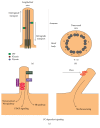New Roles of the Primary Cilium in Autophagy
- PMID: 28913352
- PMCID: PMC5587941
- DOI: 10.1155/2017/4367019
New Roles of the Primary Cilium in Autophagy
Abstract
The primary cilium is a nonmotile organelle that emanates from the surface of multiple cell types and receives signals from the environment to regulate intracellular signaling pathways. The presence of cilia, as well as their length, is important for proper cell function; shortened, elongated, or absent cilia are associated with pathological conditions. Interestingly, it has recently been shown that the molecular machinery involved in autophagy, the process of recycling of intracellular material to maintain cellular and tissue homeostasis, participates in ciliogenesis. Cilium-dependent signaling is necessary for autophagosome formation and, conversely, autophagy regulates both ciliogenesis and cilium length by degrading specific ciliary proteins. Here, we will discuss the relationship that exists between the two processes at the cellular and molecular level, highlighting what is known about the effects of ciliary dysfunction in the control of energy homeostasis in some ciliopathies.
Figures




References
Publication types
MeSH terms
LinkOut - more resources
Full Text Sources
Other Literature Sources

